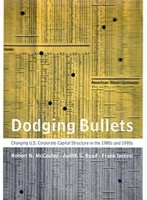| Dodging Bullets: Changing U S Corporate Capital Structure in the 1980s and 1990s артикул 2010e. |
 |
"This is a brilliant book " -- J Fred Weston, Professor Emeritus, The John E Anderson Graduate School of Management at UCLA "An excellent case history detailing the leverage excesses of the late 1980s and subsequent return to equity in the 1990s Dodging Bullets appeals to both the academic searching for an alternative views of the озчол period and the practitioner interested in lessons on managing financial crises " -- Stephen C Vogt, Department of Finance, DePaul University and Mesirow Financial, Inc The late 1980s saw a huge wave of corporate leveraging The U S financial landscape was dominated by a series of high-stakes leveraged buyouts as firms replaced their equity with new fixed debt obligations Cash-financed acquisitions and defensive share repurchases also decapitalized corporations This trend culminated in the sensational debt-financed bidding for RJR-Nabisco, the largest leveraged buyout of all time, before dramatically reversing itself in the early 1990s with a rapid return to equity This entertaining summary of the broad reshaping of U S corporate finance in the last decade and a half looks at three major issues: why corporations leveraged up in the first place, why and how the leverage wave came to an end, and what policy lessons are to be drawn Using the Minsky-Kindleberger model as a framework, the authors interpret the rise and fall of leveraging as a financial market mania In the course of chronicling the return to equity in the 1990s, they address a numberof important corporate finance questions: How important was the return to equity in relieving corporations' debt burdens? How did the return to equity affect the ability of young high-tech firms to finance themselves without selling out to foreign firms?. ChamborСуперобложка ISBN 0262133512. |